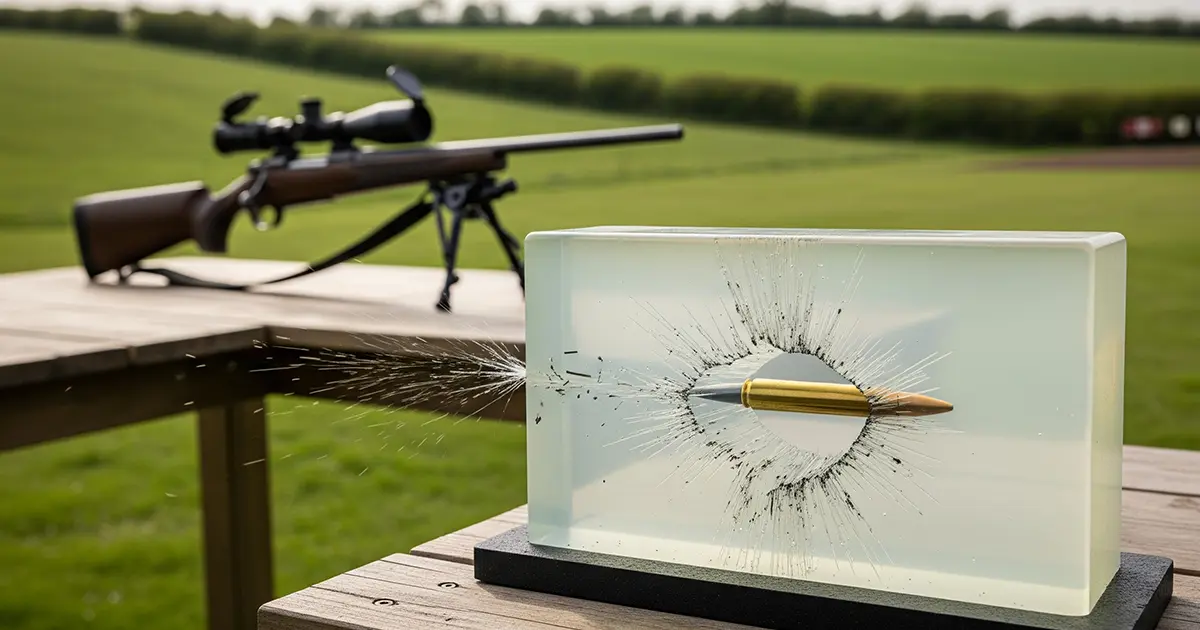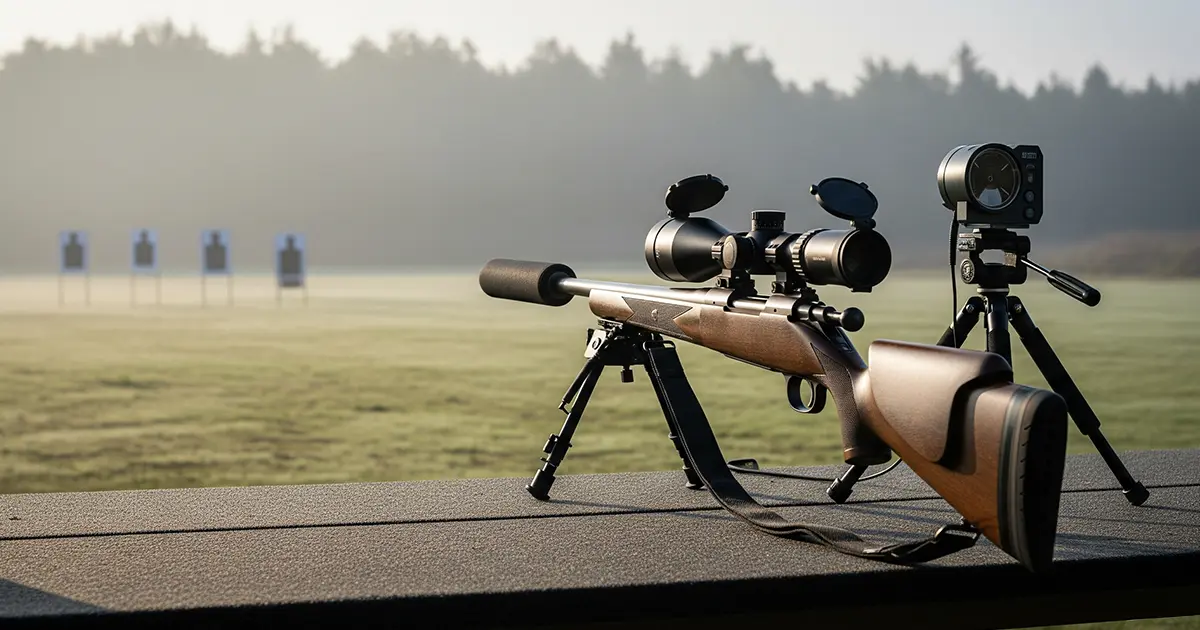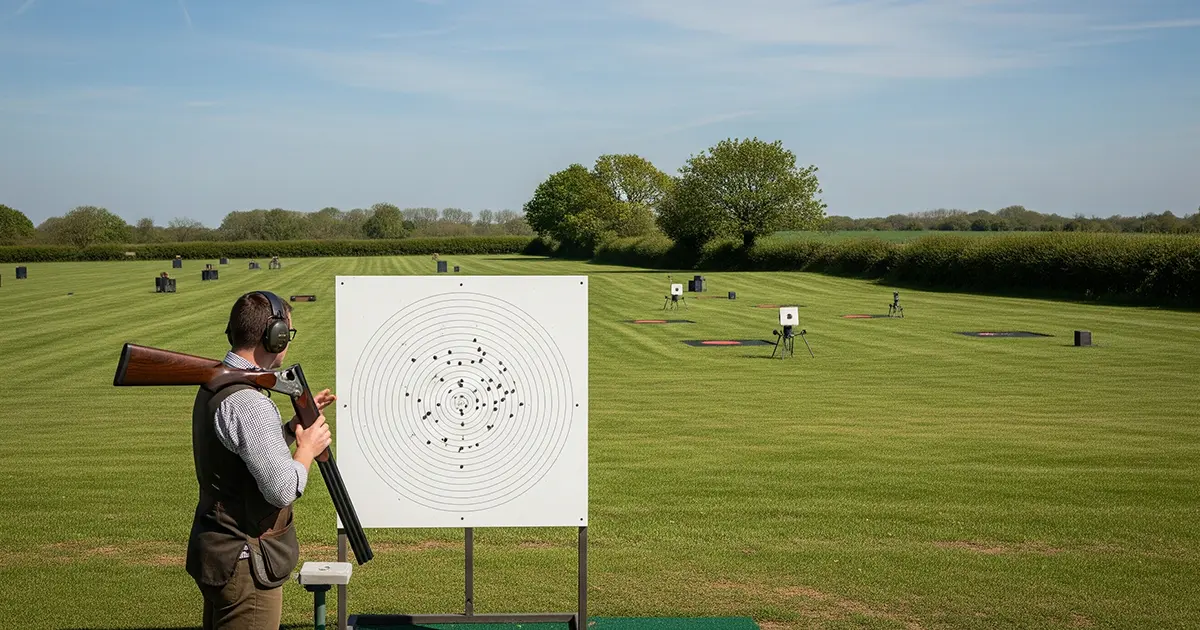Good shooting is equal parts science and sense. This guide breaks the science into plain English, then shows how to apply it in the field. It is written for deerstalkers, vermin controllers and clay or game shots who want clean, predictable results and fewer variables.
Where it helps, we point to current UK rules and proof matters, because sound ballistics only works when it is legal and safe.
What each area covers, and why it matters
Internal ballistics is what happens from primer strike to the bullet exiting the crown, where chamber pressure, barrel time and rifling twist set the stage for consistent muzzle velocity and bullet stability. Seating depth and how close a bullet sits to the lands can change pressure, sometimes sharply as you approach or touch the rifling, so any change here demands a fresh pressure check and re-zero. bergerbullets.com
External ballistics is the bullet’s flight. The big players are gravity, drag, wind, and, at long range, the transonic region and smaller effects like spin drift and Coriolis. Using G7 ballistic coefficients for modern boat-tail bullets generally gives better predictions than G1, and Doppler-based solvers improve things further. Scottish Government, static.hornady.media
Terminal ballistics is what the bullet does on impact. Bullet construction dictates the expansion window. For example, Hornady state ELD-X is designed to expand down to roughly 1,600 fps, and Federal’s Terminal Ascent has been tested to expand near 1,400 to 1,500 fps, which is why impact velocity matters as much as group size on paper. Gel is a useful comparator, provided it is properly calibrated, but it is not a living animal. hornady.com, hornadyle.com
Internal ballistics you can actually use
Twist rate and stability
Longer bullets need more spin. A simple rule of thumb is to keep gyroscopic stability factor Sg at 1.4 or higher at the muzzle, with little to gain above about 2.0. Copper bullets of the same weight are longer than lead core, so they often need a faster twist. Check with a reputable stability calculator before you buy a case of ammunition. Lapua, bergerbullets.com
Seating depth, the lands, and pressure
Pushing a bullet out to touch the rifling can raise peak pressure. Seating longer increases case volume which tends to reduce pressure, until you get very close to the lands, at which point pressure can rise again. Any change to cartridge overall length is a material change, so work up loads again and re-chronograph.
Chronographs and trustworthy velocity
Optical chronos are sensitive to light and alignment. Barrel-mounted magnetics read well but can change barrel harmonics and point of impact, especially on lighter sporting barrels. Doppler radar units avoid POI shift because nothing touches the barrel. If you chrono with a barrel-mounted unit, remove it and confirm your zero and drops afterwards. Reddit, Applied Ballistics
Moderators and zero
Adding a moderator changes weight and back-pressure at the muzzle, which alters barrel harmonics. Expect a shift in point of impact and sometimes group size. Fit the moderator you will actually use, then zero with it in place and record both suppressed and bare data in your log. The Truth About Guns
“Internal consistency, not raw speed, is what kills variables. If you change anything at the muzzle or in the chamber, treat it like a new system and verify from scratch.”
David Bellamy, Managing Director, The Instinctive Shooter
External ballistics made simpler
Zero choice
Pick a zero that matches your use. Woodland roe at 100 metres suits a 100 m zero. Open hill can favour a 200 m zero to buy a little more point-blank range.
BC choice and solver setup
Select G7 for long, modern boat-tails rather than G1. If your app offers a custom drag curve from Doppler data, use it. Enter sight height carefully, measure from bore centre to scope centre, and use station pressure if your solver asks for it. Truing is normal: confirm real drops at distance, adjust muzzle velocity first around Mach 1.2, then use the solver’s drop-scale or BC truing if needed. Scottish Government, Rokslide, Applied Ballistics
Transonic flight
Groups often open as bullets decelerate through roughly Mach 1.2 down to 0.8. If you need reliable hits beyond this, consider a bullet with a proven drag model and enough retained velocity to stay out of trouble, or accept the extra dispersion in your hit probability. thedeerinitiative.co.uk
Wind, spin drift and Coriolis, what actually matters
A steady 10 mph wind dwarfs spin drift and Coriolis at typical UK stalking distances. Spin drift and Coriolis become worth dialing around 800 to 1,000 metres, where they are still measured in a few inches rather than feet. Your time is better spent reading wind and terrain. Lapua, Sniper’s Hide, Wikipedia
Click values and units, avoid cross-wiring your brain
One mil equals 3.438 MOA. Most mil turrets move 0.1 mil per click, which is 1 cm at 100 m and about 0.36 inch at 100 yards. Keep your reticle, turret and app in the same system. Wikipedia, longrangeshooting.org
“Wind is king in Britain. Build a routine for it, even on the range. Call the wind, shoot, check, call again. That habit pays in the field.”
David Bellamy, The Instinctive Shooter
Terminal ballistics that drive outcome
Match construction to the job
Bonded or mechanically locked lead-core bullets offer reliable expansion and deep penetration across common impact speeds. Monolithic copper bullets keep weight and penetrate straight, but most need higher impact speeds to open fully. Know your bullet’s minimum expansion velocity and check that your real impact speed at your maximum range stays above it. Hornady publish about 1,600 fps for ELD-X, and Federal’s Terminal Ascent has been demonstrated around 1,400 to 1,500 fps. Many copper designs are happiest at 1,800 to 2,000 fps or more. hornady.com, Ron Spomer Outdoors
Gel testing, useful with caveats
Ballistic gel is a consistent medium for comparing bullets. It only tells the truth when calibrated with a .177 inch steel BB at about 590 fps for 8.5 to 9.5 cm penetration, and even then it cannot mimic bone or complex anatomy. Use it as a comparator, then overlay field results and proper shot placement. hornadyle.com
UK legal and proof essentials
Expanding ammunition
For deer across the UK, bullets must be designed to expand or deform, not solids for big game. Check your local laws if in doubt. GOV.UK
Minimums for deer
England and Wales: for all deer except muntjac and Chinese water deer, minimum calibre 0.240 inch with at least 1,700 ft·lbf muzzle energy. For muntjac and CWD, minimum 0.220 inch, 50-grain bullet and at least 1,000 ft·lbf. Scotland: for roe, at least 50 grains, 2,450 fps and 1,000 ft·lbf. For other species, minimum 100 grains, 2,450 fps and 1,750 ft·lbf. NatureScot permit 80-grain non-lead bullets for larger species provided the 2,450 fps and 1,750 ft·lbf thresholds are met. BASC, NatureScot
Lead ammunition transition
On 10 July 2025 the UK Government announced new restrictions on lead ammunition in Great Britain. The plan bans shot over 1 percent lead and bullets over 3 percent lead, with a transition starting in 2026 and running for three years, subject to specified exemptions. Northern Ireland follows EU wetlands rules separately. Keep an eye on the final legislation as it is implemented. GOV.UK
Steel shot and proof
High Performance steel cartridges must only be used in guns stamped with the CIP fleur-de-lys and “STEEL SHOT” proof, typically tested to 1,320 bar. Standard steel is widely safe in nitro-proofed guns with sensible choke, often half choke or less for larger pellets. Always match cartridge length to chamber length and, if unsure, ask us to inspect proof marks and chokes. gunproof.com, gmk.co.uk, BASC
Two real-world set-ups
Hill red stag with a 6.5 Creedmoor
Rifle zero 200 m, 143 gr ELD-X. Build the profile with true scope height and a G7 BC or the maker’s drag model. Confirm drops at 300 and 500 m, then true muzzle velocity first, before touching BC. Keep your maximum range where the solver shows at least 1,600 fps on impact and where your wind call holds inside the vital zone. Re-zero with your moderator fitted and record suppressed dope. hornady.com, Applied Ballistics
Lowland duck day with steel
Check the barrels for the fleur-de-lys steel proof, confirm chamber length, and select HP or standard steel accordingly. If your gun lacks HP proof, choose standard steel in appropriate shot sizes and keep choke at half or less with larger pellets. Pattern the load, then note the slight POI changes that sometimes appear when moving from lead to steel. BASC
“The pattern board is honest. Ten shots on paper with your chosen steel load and choke will tell you more than a month of guessing.”
David Bellamy, The Instinctive Shooter
Practical tips that remove variables
- Measure scope height with callipers, centre-to-centre, not a guess. Enter station pressure in your solver, or pair barometric pressure with altitude correctly. Rokslide
- Use G7 BCs for modern long range bullets. If your app offers a custom drag file, use it. Scottish Government
- Calibrate your scope tracking once, then apply a correction factor in the app. Applied Ballistics
- Confirm drops near Mach 1.2 first when truing, then confirm again past 600 m if you shoot that far. Applied Ballistics
- Re-zero any time you change moderator, ammunition lot, or seating depth. Expect a POI shift with a moderator. The Truth About Guns
How The Instinctive Shooter can help
- Ballistic set-up session, we build your solver profile, measure your rifle properly, and true it on steel.
- Chronograph service, Doppler or barrel-mount, then a confirmatory zero.
- Moderator supply and fitting, followed by a fresh zero and drop chart.
- Steel-ready checks, proof mark verification, choke advice, and pattern testing.
- Non-lead guidance, from twist-rate suitability to expansion windows.
“We treat ballistics as a coaching tool. Get the numbers right, then blend them with fieldcraft and shot discipline. That is how clients take confident, ethical shots.”
David Bellamy, The Instinctive Shooter
Quick reference
- 1 mil equals 3.438 MOA. One 0.1 mil click equals 1 cm at 100 m. Wikipedia, longrangeshooting.org
- FBI-style gel calibration: .177 inch steel BB at about 590 fps for 8.5 to 9.5 cm penetration. hornadyle.com
- Scottish deer, non-roe minimums: 100 grains, 2,450 fps and 1,750 ft·lbf. Roe: 50 grains, 2,450 fps and 1,000 ft·lbf. NatureScot
- GB lead restrictions announced 10 July 2025, transition begins 2026. GOV.UK
- HP steel requires the CIP fleur-de-lys mark. gunproof.com
Straight Answers to Common Ballistics Questions
Do I Need to Re-Zero When Changing Ammunition Brand or Bullet Weight?
Yes. Even small differences in bullet design or velocity can shift your point of impact. A quick re-zero confirms your data and avoids surprises in the field.
Why Does My Ballistic App Show Different Drops Than the Range?
Ballistic apps rely on accurate inputs. Errors usually come from entering the wrong sight height, using G1 instead of G7 BC for modern bullets, or not inputting local pressure and temperature correctly.
What Is the Best Zero Distance for UK Deer Stalking?
For woodland roe, a 100 metre zero is straightforward and practical. On open ground, a 200 metre zero can extend your point-blank range, but you must know your drops if you choose it.
Can I Use Match Bullets Like ELD-M for Deer in the UK?
No. By law you must use expanding ammunition for deer in the UK. Match bullets are not designed to expand reliably, which raises both welfare and legal concerns.
At What Distance Does Wind Start to Matter for Accuracy?
Wind is always the biggest external factor, even at 100 metres. Beyond 200 to 300 metres, a modest breeze can move your shot several inches, so reading wind matters more than accounting for spin drift or Coriolis effect.
Can My Shotgun Safely Shoot Steel Cartridges?
Only if it has the correct proof marks. Standard steel can be used in many nitro-proofed guns with sensible choke, but High Performance steel requires the CIP fleur-de-lys proof mark.
Why Do My Groups Open Up as Bullets Slow Down?
This often happens as bullets pass through the transonic region, roughly Mach 1.2 to 0.8. Stability changes and drag variation can cause dispersion, which is why bullet choice and retained velocity are critical at longer distances.




